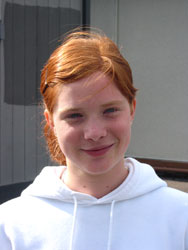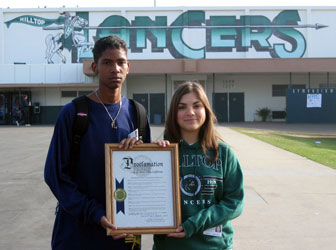|



























| |
YOUNG
PEOPLE AND POLITICS
by
Beatrice Morlin and Lara Tedesco
|
|
While
we were in
America
we had the opportunity to attend the presidential elections on
November 2nd.
|

Beatrice
on the San Diego-Los Angeles train |
Signs
in favour of Bush or Kerry were everywhere, even outside the houses,
and many cars had bumper stickers supporting one of them.
It was quite unusual for us too see all these people which showed
freely their political preferences, as in
Italy
the vote is something that belongs to everyoneís private life.
We were surprised when even at school we took part in a lesson whose
main topic was politics; during this government class students
pretended to organize an election: first of all they checked on the
net for some information about the political programs of the two
candidates, then they expressed their vote on a paper. Kerry won in
the class, but, as everybody knows, it did not reflect the choice of
the majority of the American citizens. |
|
Some
of us went to the polls to see the American vote system; it is not
so different from ours. After voting there is a machine where you
put your paper so your vote remains secret.
|
|
And
what about the relationship between young people and politics? We
collected different ideas among the Italian students: some of us
thinks that American young people are interested in this issue,
wheares someone else is convinced youngsters do not care much about
it.
We realised that it depends on several things, for instance the
family you belong to, the friends you go out with and how much
"American" you feel; we were in San Diego, a city close to
the Mexican border, and we found out that the families coming
from Mexico and who still have a strong link with their country of
origin do not feel much involved in the American political life.
|

Lara
is the driver on the same train |
|
INTERVIEW
TO MICHAEL "CODY"
MONROE,
A
PRINCIPALíS ROUNDTABLE MEMBER
by
Jessica Santi
|

Jessica
@ Hilltop High
|
Whatís
a principalís roundtable?
Itís a council where the principal and some students try to solve
problems that students of
Hilltop
High
School
might have with the school system, with teachers and so onÖ we do
this to improve the relationship between students and the school.
Who
chooses the students of the roundtable?
This is my job! I have to look for students who have the qualities
to voice their opinions, who have good ideas. I have to choose
thirty students, eight for each grade; it doesnít matter if
theyíve physical limitations, as you will see if you take part to
a meeting, or if they arenít American but their parents are
Japanese or Mexican. We are all equal and we all have the same
importance. |
|
But
you, youíre a bit more important than the other members because
you get to choose them. The principal gave you this
job, didnít he?
Yes, the principal gave me this task, but only because Iím the
oldest member of the council and itís the fourth year that I have
been in the roundtable. This is the only reason, but Iím as
important as the other students. I canít take decisions by myself.
|
|
Is
it an obligation to be a principalís roundtable member?
No, of course not. If you donít want to have this responsibility,
Iíll choose somebody else; however, I think that being a member of
the council is a privilege.
When
do you meet?
We meet once a month, on a Tuesday, usually the first half of the
month.
And
where do you meet?
We meet in the library of the school. We arrange ourselves in a
circle with desks and chairs. In front of each of us, there is a
sign with our name printed on. |

Jessica
with Michael "Cody"
Monroe, senior member of the Principal's roundtable |
|
What
else can you tell us about the council?
During the first meeting, we
elect five students for the School Site Council.
What
is a School Site Council?
Itís a meeting between
teacher representatives, parents representatives, five of the
principalís roundtable members and the principal.
What
is it for?
This council is more important than the roundtable. It takes
decisions on how to spend the school money, on
school rules, etc.
Thank
you very much for your time and for the information, good bye!
Youíre welcome, good bye! |
|
CALIFORNIA
AND ITALY: TWO DIFFERENTS WORLDS
di
Jhoan Rodriguez
|
|
After
living in
California
for two weeks, I can say that itís different from Italy
in many aspects.
First of all, Californian people generally are more sociable: Iím
referring to the way they deal with other people.
For example, when they see someone they donít know who needs help
or something, Americans (and particularly Mexicans) will give
a hand or call for help. Italians, on the contrary, will just
pretend that nothing has happened.
|
|

Jhoan
Rodriguez (left) @ Hilltop High
|
In
my view, they are very patriotic: for example, students start every
school day with a sort of national anthem.
What is more, the classrooms are full of posters of the
US
flag. This sense of belonging is something that is more and more
lacking in Italy
.
Another difference between California
and Italy
is that shop assistants donít care if you spend hours and hours
just looking around without buying anything (unlike in Italian shops!).
And what is more, if you buy something, they will honestly tell you
what costs more and what less. |
Sometimes they will even tell you if the same item is sold by another
shop at a
lower price!
As far as school and education are concerned, there are lots of
differences too. |
|
First of all, American students choose most of the subjects
they study, and then they have the same subjects every day all year
long.
Their choice is not very varied, however: for example,
philosophy and many other subject we study do not exist in American
schools.
But they do have real theater lessons in a real theater, with
costumes, make-up, a stage and so on..
|

Jhoan,
working hard to collect information for his article ... |
|
Secondly, their classrooms are covered with lists of
rules; however,
they are not always respected.
In
all public schools both smoking and drinking alcoholics is forbidden,
and those who break these rules get in trouble!
In
America
you are allowed to drive at the age of 16, but you cannot smoke
until you are 18 and drink until you are 21. Ití s something
established by American law, which is really strict in case of
transgression, probably more than the Italian one.
Finally, I noticed that a lot of things, if compared with
Italian ones, are bigger: from the bottles of water to the houses
and hotels and to the shops.
Ití s easy for an Italian to get lost in a mall like Plaza Bonita
or Horton Plaza, which count more than 50 different shops inside! It
is always a good idea to remember to bring a map!
|
|
Foto: © Nicoletta
Galante 2004 |
|